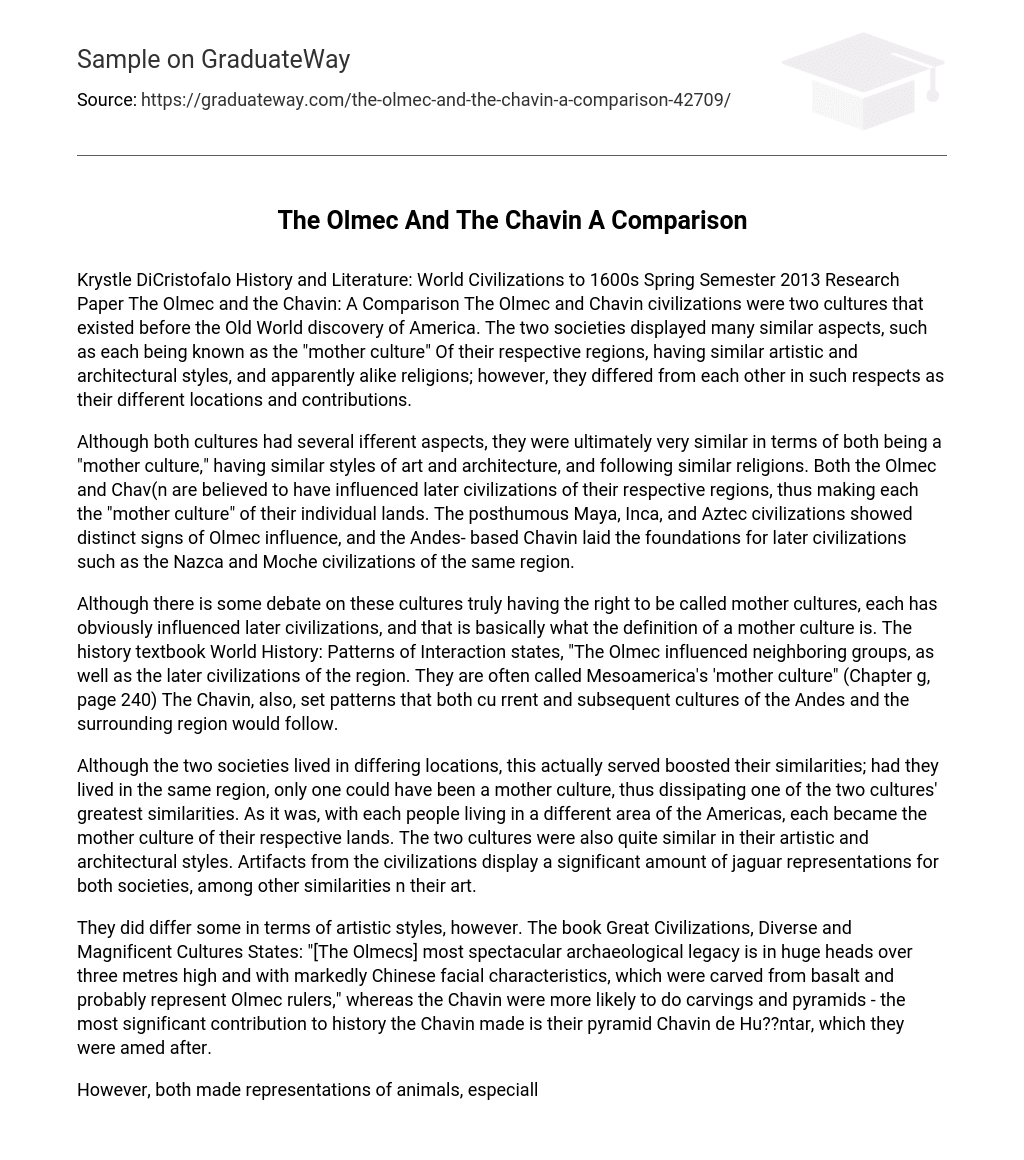Krystle DiCristofaIo History and Literature: World Civilizations to 1600s Spring Semester 2013 Research Paper The Olmec and the Chavin: A Comparison The Olmec and Chavin civilizations were two cultures that existed before the Old World discovery of America. The two societies displayed many similar aspects, such as each being known as the “mother culture” Of their respective regions, having similar artistic and architectural styles, and apparently alike religions; however, they differed from each other in such respects as their different locations and contributions. Although both cultures had several ifferent aspects, they were ultimately very similar in terms of both being a “mother culture,” having similar styles of art and architecture, and following similar religions. Both the Olmec and Chav(n are believed to have influenced later civilizations of their respective regions, thus making each the “mother culture” of their individual lands. The posthumous Maya, Inca, and Aztec civilizations showed distinct signs of Olmec influence, and the Andes- based Chavin laid the foundations for later civilizations such as the Nazca and Moche civilizations of the same region.
Although there is some debate on these cultures truly having the right to be called mother cultures, each has obviously influenced later civilizations, and that is basically what the definition of a mother culture is. The history textbook World History: Patterns of Interaction states, “The Olmec influenced neighboring groups, as well as the later civilizations of the region. They are often called Mesoamerica’s ‘mother culture” (Chapter g, page 240) The Chavin, also, set patterns that both cu rrent and subsequent cultures of the Andes and the surrounding region would follow. Although the two societies lived in differing locations, this actually served boosted their similarities; had they lived in the same region, only one could have been a mother culture, thus dissipating one of the two cultures’ greatest similarities. As it was, with each people living in a different area of the Americas, each became the mother culture of their respective lands. The two cultures were also quite similar in their artistic and architectural styles. Artifacts from the civilizations display a significant amount of jaguar representations for both societies, among other similarities n their art.
They did differ some in terms of artistic styles, however. The book Great Civilizations, Diverse and Magnificent Cultures States: “[The Olmecs] most spectacular archaeological legacy is in huge heads over three metres high and with markedly Chinese facial characteristics, which were carved from basalt and probably represent Olmec rulers,” whereas the Chavin were more likely to do carvings and pyramids – the most significant contribution to history the Chavin made is their pyramid Chavin de Hu??ntar, which they were amed after. However, both made representations of animals, especially were-jaguars and other anthropomorphic creatures. They also built pyramids, and were among the first civilizations to do so. Inside Chavin de Hu??ntar, the Chav(n people’s famous pyramid, there are many abstract and beautiful artistic carvings. The online Encyclopedia Britannica article “Chavin” says, “The principal motifs of the Chavin style are human, avian, feline, and crocodilian or serpentine figures; these were often combined in highly complex and fantastic images.
Chavin art seems to have been generally more complex and harder to understand than the more straightforward Olmec art; however, the analogous images each culture depicted show similar creatures such as the discussed were-jaguars. The were-jaguars were also important to the Olmec and Chav[n religions, as will be shown below. The Olmec and Chavin had quite similar religions. Both were polytheistic, and they also worshipped jaguar and were-jaguar deities ??” a jaguar god was likely the main god of each culture – as well as serpentine deities. The “Central Andes: Chavin” online rticle says, “The feline is a central figure in this [Chavin] belief system, and its presence is seen in human forms that hold scepters adorned with large curved fangs. ” Although there is little known about either religion, feline and serpentine deities were most certainly conspicuous parts of both civilizations. There was also a good deal of significance put on shamanism for the two belief systems. In fact, the Olmecs believed their shamans to be spiritually connected to the jaguars they worshipped.
Kimberly Lavin quotes anthropologist Peter Furst in her “The Olmecs: A Mesoamerican Wonder” as aying, ” ‘in tropical America, jaguars were the shamans of the animal world, the alter ego of the shaman. They are the most powerful predators. ‘ ” Both the Olmecs and the Chavin believed in shamans, who were their spiritual leaders, and to the Olmecs, jaguars and shamans were just different aspects of each other ??” alter egos. Also, another similarity between the two religions is the likelihood of religious sacrifice.
Evidence, including bloodletting and sacrificial equipment found in Olmec sites, points to the probability of the Olmecs practicing human sacrifice. In contrast, however, the Chavin seem to have practiced mostly animal sacrifice. However, there were many similarities between the Olmec and Chavin religions, and the above examples show this. Through the various aspects of the Olmec and Chavin cultures, it can be seen that the similarities overpowered the differences. Despite the fact that the Olmec and Chavin lived in different parts of the Americas, the two civilizations possessed many resemblances to one another.





